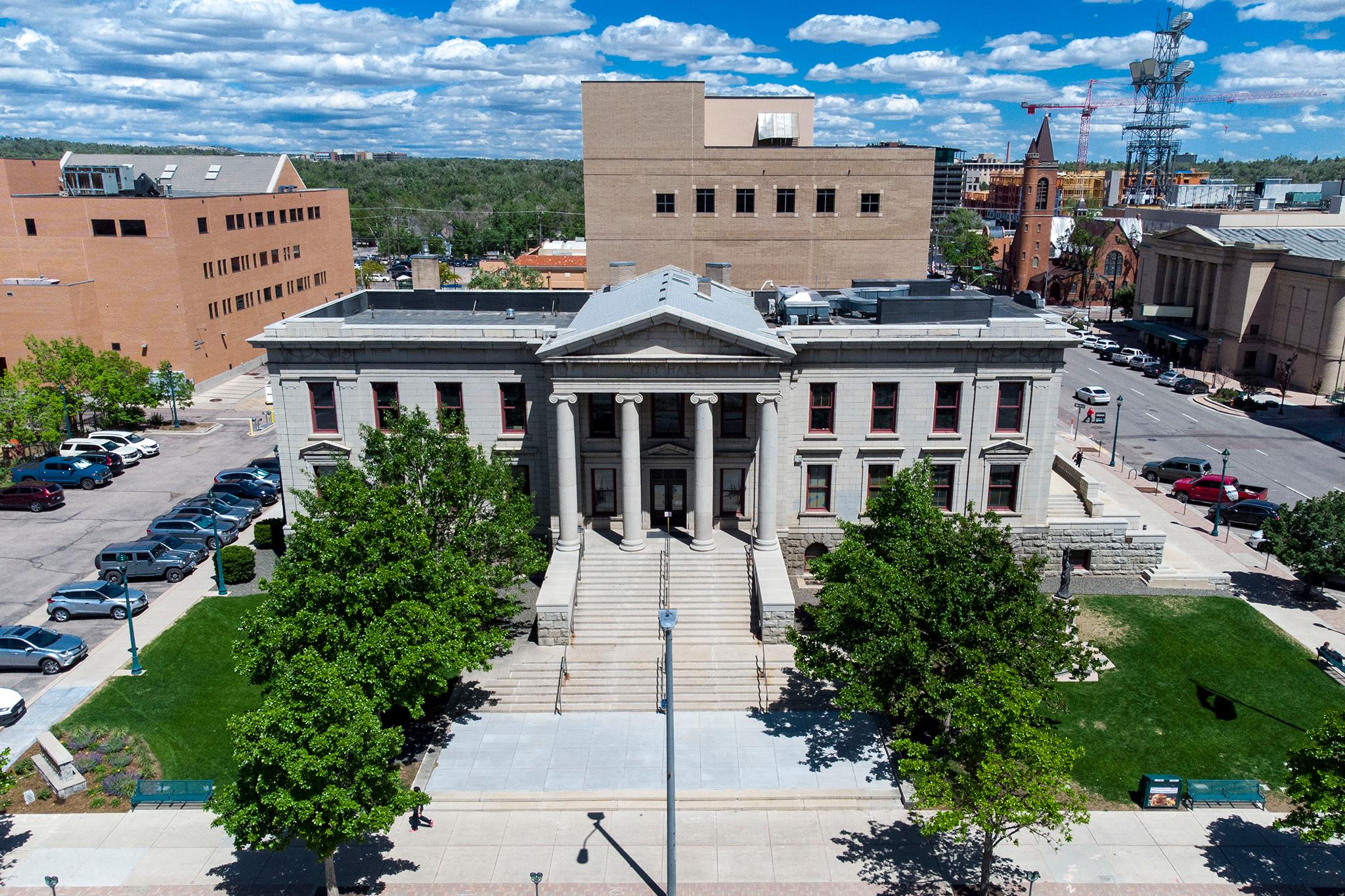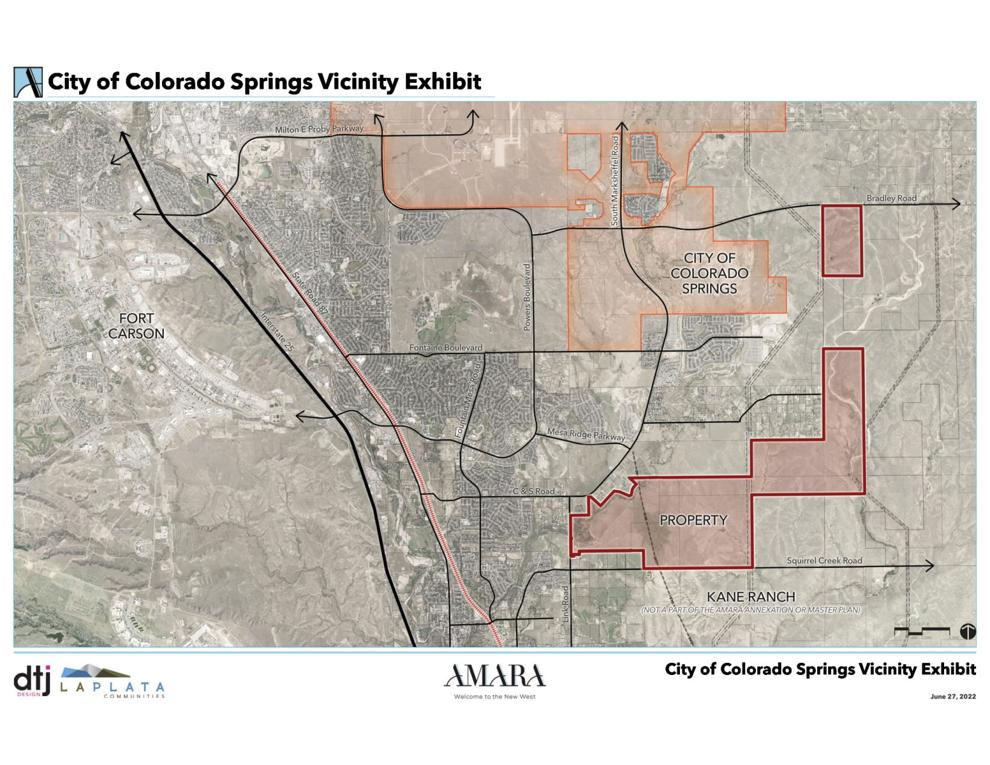
A proposal for Colorado Springs to annex nearly 3,200 acres that do not touch the city limits, but is adjacent to Fountain, is generating controversy. If the annexation is approved it could eventually become the site of some 9,500 homes of different types.
It's part of what's known as the Amara development from La Plata Communities, which, as proposed, would also include commercial uses, parks and other amenities. La Plata Communities first proposed the annexation last fall.
Proponents say the housing is much needed for fast-growing Colorado Springs and would produce substantial economic benefit for the region.
But at a recent town hall, many people spoke against the annexation. Longtime Colorado Springs resident Anna Lopez was among them.
“Colorado Springs is fast outgrowing its water supply and is stressing its police and fire services,” she said. “To annex a housing project that does not abut the city does not make any sense.”
Like others, Lopez said she’s concerned about future water supplies as more people move to the region. “Money does not translate into water when the supply of water is not there,” she said. “Can we drink money? Can we magically make it into water? I don't think so.”
Fountain previously paused annexations to evaluate needed infrastructure, services and other resources.
The Amara annexation request includes two parcels. One is smaller and sits about a half mile due east of Colorado Springs, along Bradley Road. The other is further south near Fountain. Neither one borders Colorado Springs.

Proponents say the housing is much needed for fast-growing Colorado Springs and would produce substantial economic benefit for the region. Many residents spoke against the annexation at a recent town hall.
To meet state statutes, the proposal would require what’s known as a flagpole annexation, which means the city would acquire a series of narrow parcels running east from city limits along Bradley Road to reach one of the parcels under annexation consideration.
The east and south parcels also do not border each other, but there is state owned property in between, which can be used to meet the state requirements, according to city officials.
Randy Rocha is a board member of the Military Affairs Council of the Colorado Springs Chamber and Director of Development for Harrison School District 2, although he introduced himself at the public comment meeting as a city resident. He said that housing added by the Amara project could allow some Fort Carson troops to move off base and other local military installations to grow.
“So all those things are a good footprint,” he said, “(It) allows for deployments for families to stay in tighter communities and stick around during that process, maybe even retire here.”
Most people spoke in opposition to the project though, including Steven Arce of Fountain, who is a Family Advocacy program specialist at the United States Department of the Army. He said he thinks the developer’s premise that the proposed homes at Amara will help with the city’s housing crunch is misleading.
“These aren’t parallel tracks. It’s a train crash. Because one negates the other, it appears.”
-Colorado Springs City Councilman Bill Murray on the annexation and the need for water
“I work with a lot of young families, particularly young military families," Arce said, "and what we need is affordable housing. $400,000 homes are not affordable. $2,000-a-month rents are not affordable. We actually need affordable housing to be able to address this.”
“I would never go to another city to tell you how to take care of your city,” Arce added, "but in certain ways this is…one city kind of wanting to override the sovereignty of Fountain when it comes to us not being involved in this.”
Fountain deputy city manager Todd Evans said it would create a number of challenges for his community.
“Will this impact our public safety in Fountain? Absolutely,” Evans said. “Our officers will have to do the right thing and they will have to go in and serve until Colorado Springs folks get down there. That's just the nature of the beast.”
Evans said other problems could also result from the project, like traffic and drainage issues.
City would have to provide utilities and services to Amara homes
As part of the annexation proposal, Colorado Springs is being asked to provide services for Amara, including water. Estimates for Colorado Springs Utilities to add the capacity to serve Amara with electricity, natural gas and water are between $111 million and $167 million.
According to city staff, Amara’s projected demand for water is about 3,500 acre feet a year, an amount the city can meet at this time. However, additional water supplies would need to be developed to meet future demand.
The developer would be required to pay for the expense of extending the existing water distribution.
A consultant hired by the city and paid for by the developers conducted a fiscal and economic impact analysis. It found that the Amara project could generate thousands of jobs and billions of dollars for the region and that there would be enough revenue to cover the city’s costs of annexation.
But council members Nancy Henjum and Bill Murray questioned the validity of the numbers during a work session prior to the public comment meeting.
“It seems like the numbers the developer gave (the consultants) might be a little aggressive,” Henjum said. Based on a report on home prices from a national real estate consulting firm and El Paso County permitting trends, she wondered if the developer could achieve the projected buildout numbers for Amara.
Council also considers an ordinance covering extending water service outside of the city
Colorado Springs City Council is also considering a new ordinance regarding extending water service to new areas. The exact requirements are still under consideration, but in its current iteration, the city would be required to have enough water supply available to meet 130 percent of its existing usage, along with the projected demands of a new service area. It also addresses state laws on how much of the new area would have to border the city in order to extend water service.
Approval of the water ordinance and the Amara annexation are two independent issues proceeding on their own tracks, according to city staff.
Henjum suggested during an earlier council work session that they pause consideration of the ordinance regarding the extension of water services until they’d gotten more public and stakeholder input and some of the numbers and methodologies are clarified. She also said that although the city needs additional housing, she would like the council to hold off on the Amara annexation until the water service extension ordinance is in place.
Councilman Dave Donelson agreed with Henjum, to a point.
“We need to remember there are real positives to annexing new areas into our city,” Donelson said. “When we block these annexations it has impacts in other areas we aren’t even considering.”
He also said council needed “to slow down on the (water service extension) ordinance and there’s no need to rush to pass something and we need to keep these things on separate tracks.”
But Councilman Murray said their relationship is too intertwined.
“These aren’t parallel tracks. It’s a train crash. Because one negates the other it appears.”
There will be more public comment periods on the Amara annexation during the Nov. 9 Colorado Springs Planning Commission meeting and the Nov. 22 City Council session. Colorado Springs Utilities is currently taking public comment on the water service extension ordinance.









